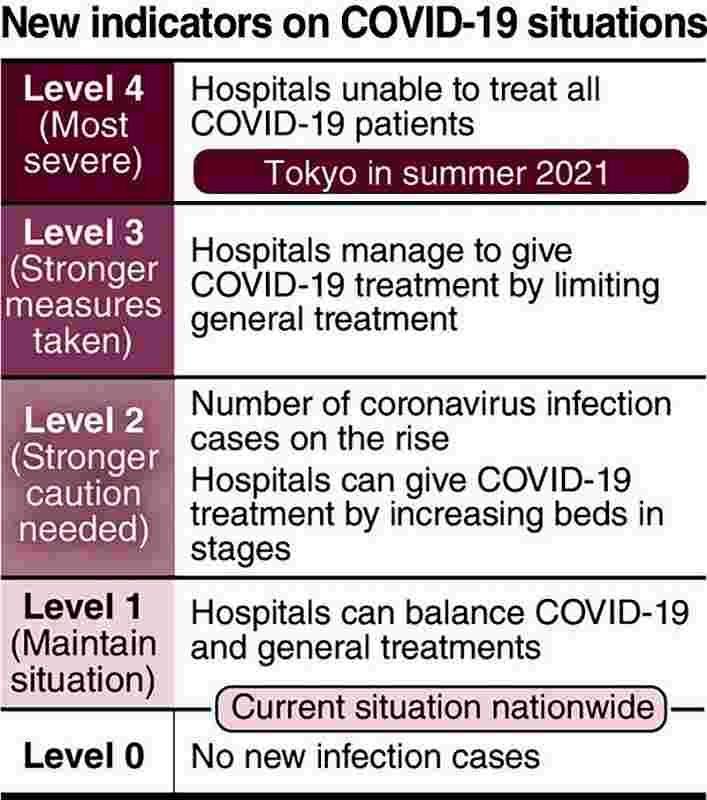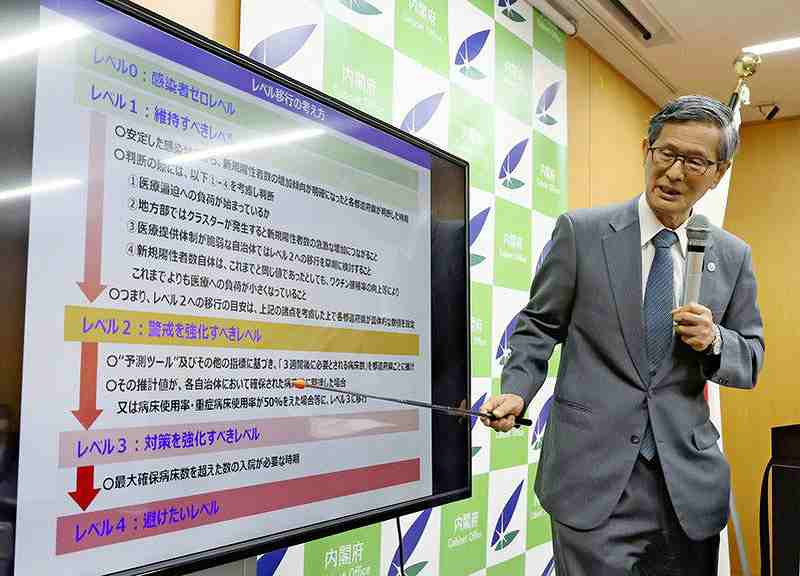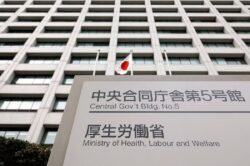
November 9, 2021
The government’s COVID-19 control subcommittee has revised the criteria used to assess novel coronavirus infection situations based on the strain placed on the health care system, rather than on the number of newly confirmed cases.
The subcommittee compiled Monday new standards for government decisions on declaring a state of emergency or taking other control measures. It will also change its classifications from the current four stages to five levels. In light of changed circumstances, such as widespread vaccination and the development of drug treatments, the government aims to revive social and economic activities while avoiding strain on the medical system.
The levels are determined by prefectural governments, which periodically monitor and forecast medical capacity. The committee also presented appropriate measures to be taken at each level.
Strong measures, such as a state of emergency and emergency-level priority measures, are taken beginning at Level 3, the second most serious situation, which is equivalent to the current Stage 3 or Stage 4.
Level 3 is defined in one of two ways: Either the hospital bed occupancy rate exceeds 50%, or beds are on track to become fully occupied within three weeks.
Level 4, the most serious, requires the government to intervene to provide disaster medical care because hospitals have become unable to cope with COVID-19 patients even if they drastically limit general medical treatment. This was the situation this summer in Tokyo, where many people died while waiting for medical treatment at home.

Shigeru Omi, head of the government’s COVID-19 control subcommittee, explains new standards to assess coronavirus infections on Monday.
The current situation in each prefecture is either Level 0, with no new infection cases, or Level 1, at which coronavirus medical services can be provided stably. At these levels, social and economic activities can go on with basic infection control.
Level 2 is a situation in which the number of infections has started to increase. Prefectural governments will start securing hospital beds in stages and urging residents to avoid activities that put them at high risk of infection.
Each level is determined per prefecture by using a prediction tool that can estimate the number of seriously ill patients and the hospital bed occupancy rate in the coming weeks.
The current classification of stages is based on a uniform nationwide standard. Stage 4, for example, means that 25 or more people per 100,000 are confirmed to have been newly infected in a week.
However, the medical care system varies greatly from region to region, and that required the subcommittee to review its indicators. The subcommittee also took into account changes in the environment, such as a drop in the rate of serious COVID-19 patients, thanks to the spread of vaccinations.
“Prefectures know the local situation best,” said Shigeru Omi, head of the subcommittee. “We definitely want to avoid Level 4. We urge local governments to work with the central government to take proactive measures in a reasonable period of time.”
"Society" POPULAR ARTICLE
-

M4.9 Earthquake Hits Tokyo, Neighboring Prefectures
-

M7.5 Earthquake Hits Northern Japan; Tsunami Waves Observed in Hokkaido, Aomori and Iwate Prefectures
-

Israeli Tourists Refused Accommodation at Hotel in Japan’s Nagano Pref., Prompting Protest by Israeli Embassy and Probe by Prefecture
-

Tsukiji Market Urges Tourists to Avoid Visiting in Year-End
-

M5.7 Earthquake Hits Japan’s Kumamoto Pref., Measuring Upper 5 Intensity, No Tsunami Expected
JN ACCESS RANKING
-

Keidanren Chairman Yoshinobu Tsutsui Visits Kashiwazaki-Kariwa Nuclear Power Plant; Inspects New Emergency Safety System
-

Imports of Rare Earths from China Facing Delays, May Be Caused by Deterioration of Japan-China Relations
-

University of Tokyo Professor Discusses Japanese Economic Security in Interview Ahead of Forum
-

Japan Pulls out of Vietnam Nuclear Project, Complicating Hanoi’s Power Plans
-

Govt Aims to Expand NISA Program Lineup, Abolish Age Restriction




















